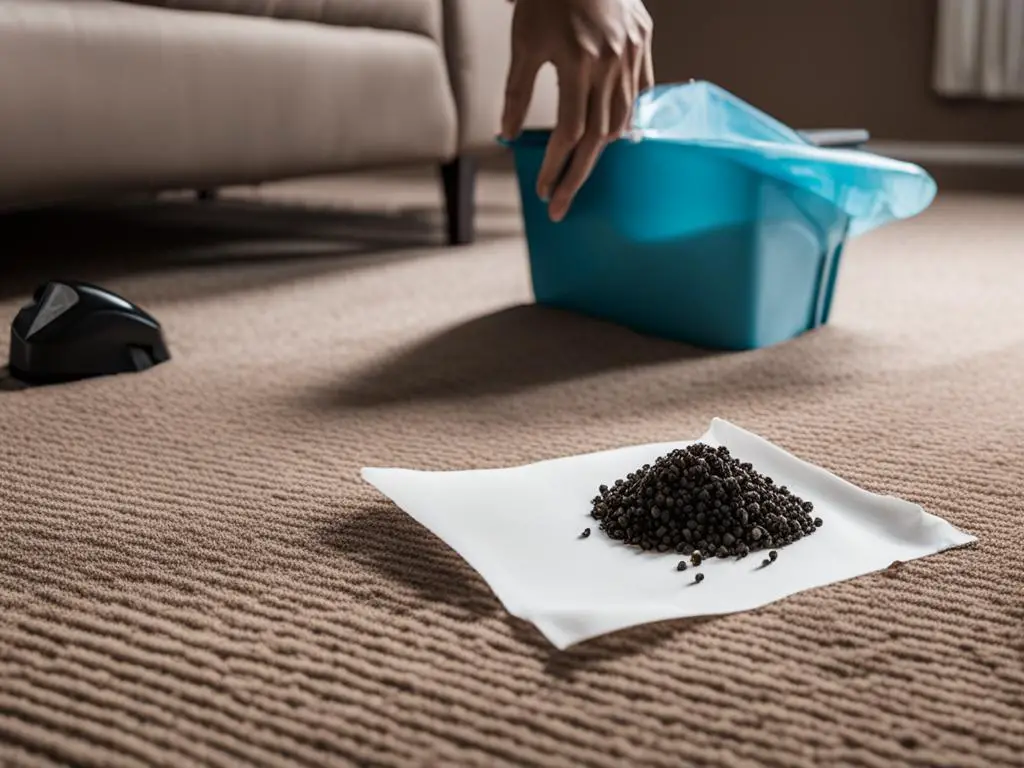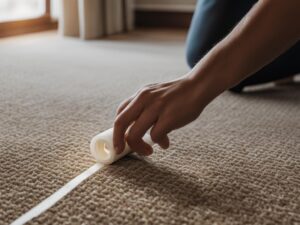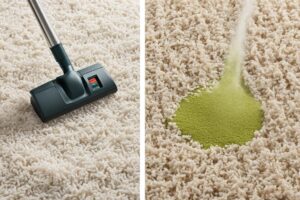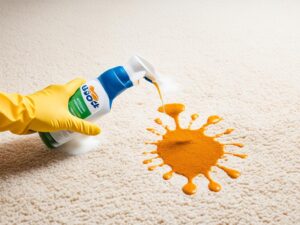Mouse droppings can be a common problem in households, especially during a mouse infestation. However, cleaning up mouse droppings from your carpet requires special precautions to ensure your safety and the prevention of any health risks. In this article, we will provide you with essential tips on how to clean mouse droppings from your carpet effectively.
When dealing with mouse droppings, it’s important to remember that they can carry diseases such as hantavirus, which can pose a risk to your health. Therefore, taking the necessary precautions is crucial to ensure a safe and hygienic cleanup. Let’s dive into some essential steps you need to follow when cleaning mouse droppings from your carpet:
Key Takeaways:
- Proper ventilation is essential before starting the cleaning process to reduce particle density and ensure a better breathing atmosphere.
- Wearing protective gloves such as rubber, latex, or vinyl gloves is crucial to protect your hands from direct contact with mouse droppings and prevent any infections.
- Avoid sweeping or vacuuming mouse droppings to prevent the hantavirus from becoming airborne. Instead, spray the droppings with a disinfectant and allow it to soak before cleaning.
- Seal the mouse droppings in a plastic bag immediately after picking them up to prevent any contaminated air or particles from spreading. Dispose of the bag in a trash can with a lid.
- Disinfect the carpet and upholstery using a carpet-safe disinfectant and wash any exposed beddings and clothes to eliminate any remaining bacteria or viruses.
Ventilating the Room
Before you begin the cleaning process, it’s essential to ensure proper ventilation in the room. By ventilating the room, you can reduce the density of particles in the air and create a better breathing atmosphere. This step is crucial to minimize the risk of inhaling harmful particles during the cleanup process.
To ventilate the room effectively, open windows and doors for at least 30 minutes. This allows fresh air to circulate, diluting any contaminants and improving indoor air quality. The increased airflow helps to remove odors and creates a more pleasant environment for the cleanup process.
Ensuring proper ventilation not only reduces particle density but also helps to eliminate any lingering smells associated with mouse droppings. It creates a healthier and more comfortable space for you to work in, promoting better overall well-being during the cleanup process.
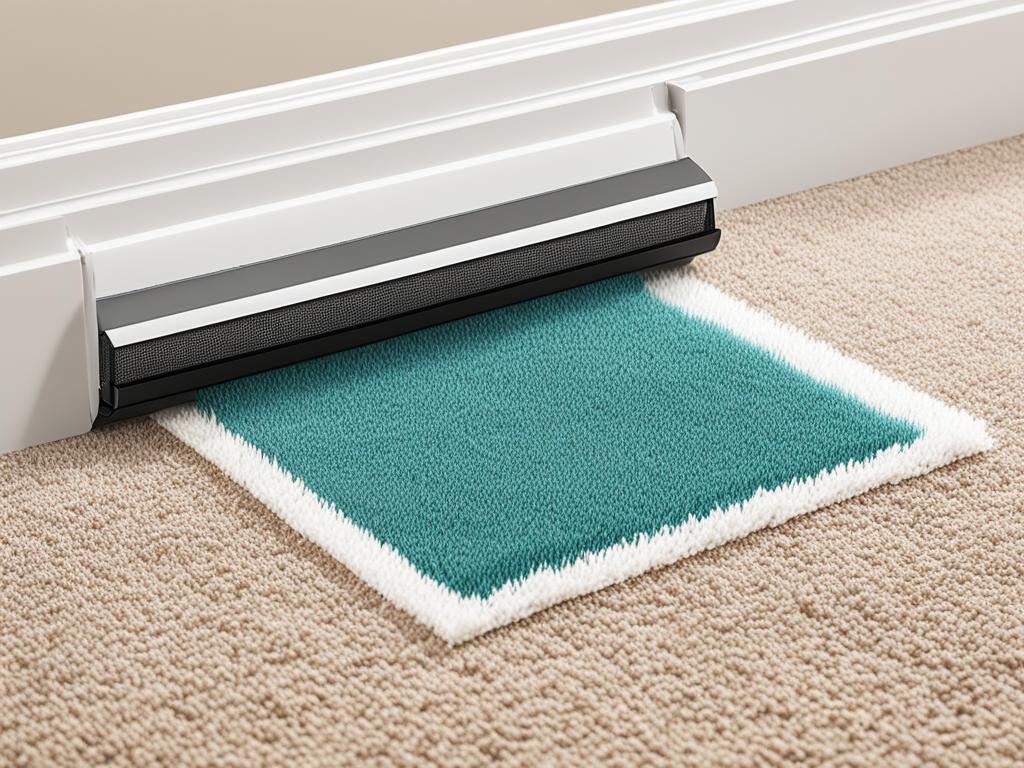
Note: It’s important to ensure a well-ventilated area while working. The image above illustrates the importance of ventilating the room for a healthier breathing atmosphere.
Wearing Protective Gloves
To protect your hands during the cleanup process, it is essential to wear rubber, latex, or vinyl gloves. These gloves act as a barrier between your hands and the mouse droppings, preventing direct contact and reducing the risk of infection, particularly from the hantavirus. Wearing gloves also minimizes the chances of skin irritation and provides added safety.
Avoid Disturbing the Droppings
To effectively clean mouse droppings, it is crucial not to disturb them by sweeping or vacuuming. These actions can potentially release harmful particles into the air, increasing the risk of spreading diseases like the hantavirus. Instead, follow these steps to safely remove the droppings:
- Spray with Disinfectant: Begin by spraying the droppings with a disinfectant spray. This will help to kill any bacteria or viruses present on the droppings, reducing the risk of contamination.
- Allow Soaking Time: Give the disinfectant some time to soak in and effectively neutralize any harmful pathogens. It is recommended to let it sit for approximately five minutes.
- Pick Up with a Paper Towel: Once the disinfectant has had enough time to work, use a paper towel to carefully pick up the droppings. Be sure to wear protective gloves to avoid direct contact with the droppings.
- Dispose of Properly: After picking up the droppings, seal them in a plastic bag to prevent any potential contamination. Dispose of the bag in a designated trash can with a secure lid to further minimize the spread of pathogens.
By spraying the droppings with a disinfectant and using a paper towel to pick them up, you can effectively remove the droppings without risking the spread of harmful bacteria or viruses. This method is safe and helps prevent the transmission of diseases like the hantavirus.
| Benefits of Avoiding Disturbance | Effects of Sweeping/Vacuuming |
|---|---|
| ➤ Prevents airborne spread of hantavirus | ☓ Increases the risk of inhaling harmful particles |
| ➤ Reduces the chances of cross-contamination | ☓ Spreads droppings to other surfaces |
| ➤ Minimizes the risk of exposure to pathogens | ☓ Enhances the possibility of infection |
Proper Disposal of Droppings
When cleaning mouse droppings, it is crucial to handle the waste properly to prevent contamination and maintain a safe environment. By following the appropriate steps for disposal, you can minimize the risk of spreading harmful particles.
To begin, seal the droppings in a plastic bag immediately after picking them up. This step is vital to prevent any contaminated air, dust, or pathogens from escaping and spreading to other areas. By securely sealing the droppings, you create a barrier that helps contain the potential contamination.
After sealing the droppings, it is essential to dispose of them in a trash can with a lid. This additional layer of protection prevents any accidental release of the waste and further minimizes the risk of contamination. The lidded trash can acts as a barrier, ensuring that the droppings are securely contained until they are collected for disposal.
Proper disposal of the droppings plays a key role in preventing contamination and maintaining a hygienic environment. By following these steps, you can effectively eliminate the risk of spreading diseases and maintain a safe space for yourself and others.
Proper Disposal Steps
- Pick up the mouse droppings using gloves or a paper towel.
- Immediately seal the droppings in a plastic bag.
- Place the sealed bag in a trash can with a lid.
By following these proper disposal steps, you can ensure that any potential contaminants are safely contained and prevent the spread of harmful particles.
Related Information:
For more information on mouse droppings cleanup, how to prevent a mouse infestation, and steps to take after cleaning, refer to the comprehensive guide in Section 8.
Additional Resources:
While proper disposal is crucial, it’s also essential to understand the complete cleanup process and prevent future infestations. Refer to the following resources for further guidance:
Mouse Infestation Prevention: 10 Tips to Keep Mice Out of Your Home
Hantavirus and Cleaning Up After Rodents
Cleaning Up After Rodents
| Disposal Method | Advantages | Disadvantages |
|---|---|---|
| Sealing in a plastic bag | ✔ Prevents contamination | ✖ Requires proper sealing and handling |
| Disposing in a lidded trash can | ✔ Provides additional containment | ✖ Requires regular trash disposal |
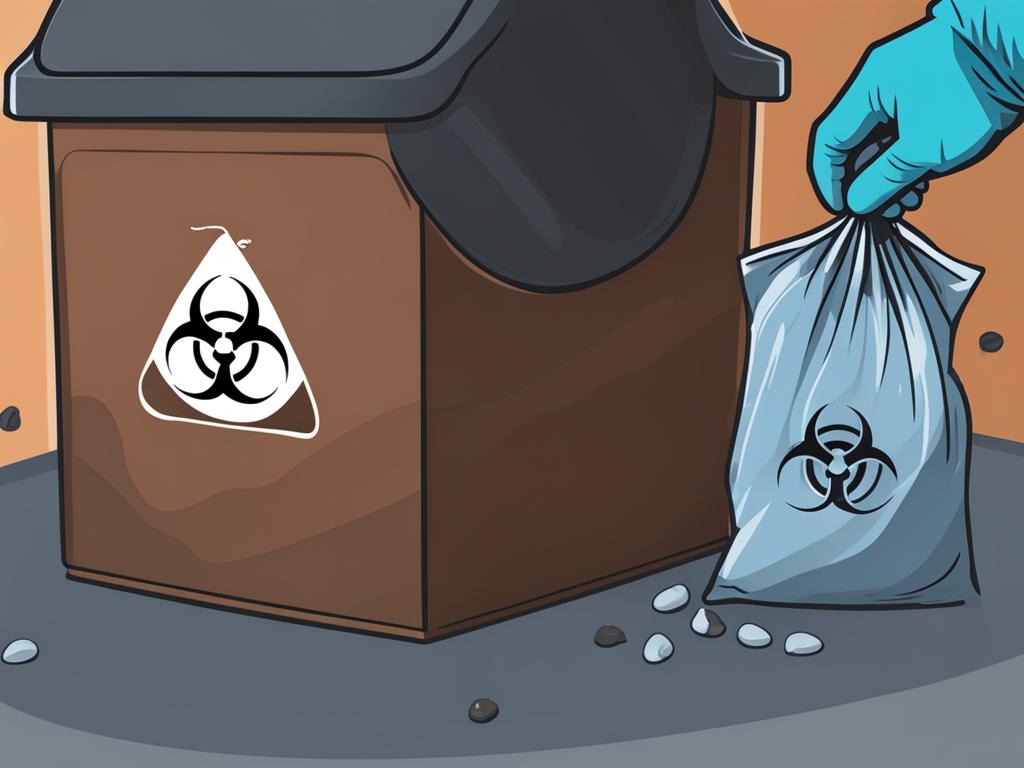
Disinfecting Carpets and Upholstery
After removing the mouse droppings, it is essential to disinfect the carpet and upholstery to eliminate any remaining bacteria or viruses. To effectively disinfect the carpets, follow these steps:
- Choose a carpet-safe disinfectant that is specifically designed to kill bacteria and viruses.
- Thoroughly spray the disinfectant onto the affected areas of the carpet, ensuring complete coverage.
- Allow the disinfectant to sit and penetrate the carpet fibers for the recommended amount of time. This will ensure that any remaining bacteria or viruses are effectively killed.
- After the recommended time has passed, use a clean cloth or paper towel to wipe off the disinfectant from the carpet.
- For upholstery, follow the manufacturer’s instructions for disinfecting. Test the disinfectant on a small, inconspicuous area first to ensure it doesn’t damage or discolor the fabric.
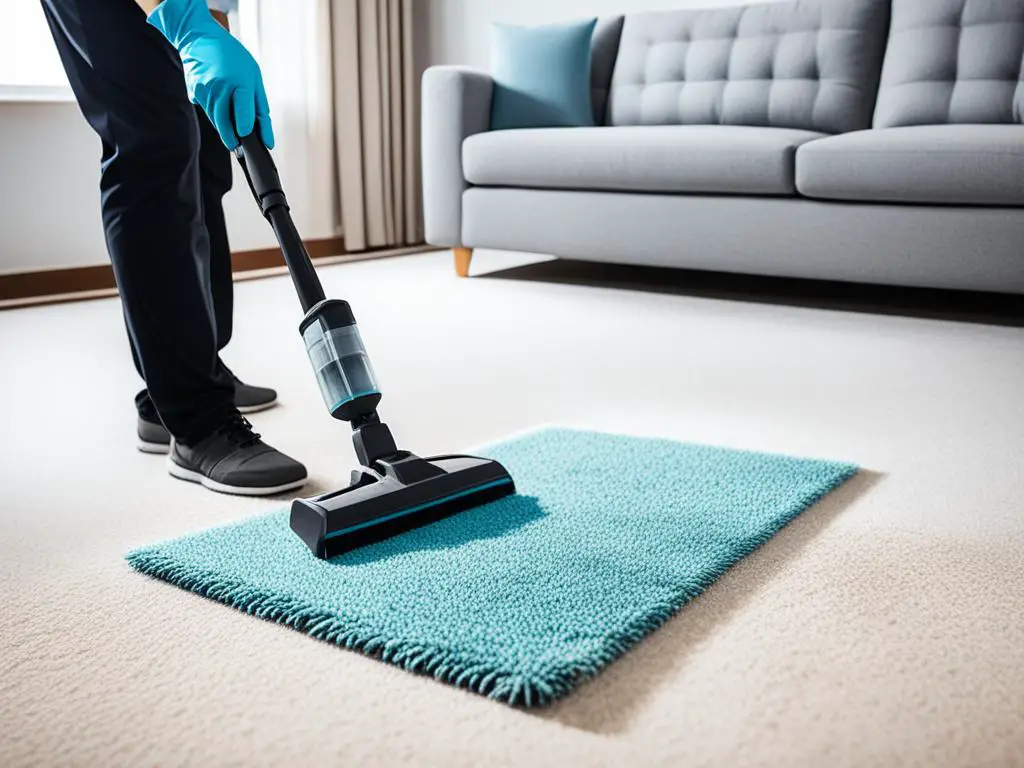
In addition to disinfecting the carpets and upholstery, it is important to wash any exposed beddings and clothes to prevent the particles from becoming airborne again. Wash them with hot water and a bleach solution to effectively kill any bacteria or viruses that may be present.
Cleaning Methods: Picking, Sweeping, and Vacuuming
When it comes to cleaning mouse droppings from carpets, there are different methods you can use – picking, sweeping, and vacuuming. Each method has its own advantages and considerations to keep in mind.
Picking Mouse Droppings
Picking up the droppings by hand is an effective method for small areas or localized infestations. This method allows you to have direct control over the cleaning process and ensures that all droppings are removed. However, it can be a time-consuming task, especially if you have a larger carpeted area to clean.
Sweeping Droppings
“Sweeping the droppings with a broom, although not recommended for carpets, can be used for hard surfaces.”
Sweeping can be a quick way to remove mouse droppings from hard surfaces such as tile or laminate flooring. However, it is important to note that sweeping is not recommended for carpets, as it can push the droppings deeper into the carpet fibers, making them more difficult to clean. If you decide to sweep, be sure to use a broom with stiff bristles and dispose of the droppings properly.
Vacuuming Droppings
Vacuuming with a high-efficiency particulate air (HEPA) filter can be an effective method for removing mouse droppings from carpets. The powerful suction of a vacuum can help to lift the droppings from the carpet fibers. However, it’s important to note that vacuuming may not be as effective for sticky or adhesive droppings that are firmly attached to the carpet. In such cases, it may be necessary to use other cleaning methods in combination with vacuuming to ensure thorough removal.
When using any of these methods, it is important to avoid spreading the droppings or stirring up dust particles. Take caution to work slowly and gently to minimize the risk of airborne particles. Additionally, always remember to properly dispose of the droppings and clean any cleaning tools or equipment used during the process.
| Method | Advantages | Considerations |
|---|---|---|
| Picking | – Provides direct control over cleaning – Ensures thorough removal |
– Time-consuming for larger areas |
| Sweeping | – Quick method for hard surfaces – Can cover larger areas |
– Not recommended for carpets – May push droppings deeper into fibers |
| Vacuuming | – Effective for carpeted areas – HEPA filter captures particles |
– May not be as effective for sticky droppings – Other cleaning methods may be needed in combination |
Conclusion
Properly cleaning mouse droppings from carpets is crucial for maintaining a hygienic environment and eliminating health risks associated with the spread of diseases. By following the proper cleaning procedures, such as ventilating the room, wearing gloves, avoiding disturbing the droppings, and disinfecting the carpet and other surfaces, you can ensure a safe and effective mouse droppings cleanup process.
Remember to properly dispose of the droppings, seal them in a plastic bag, and wash your hands thoroughly to prevent contamination. Additionally, considering professional carpet cleaning services can provide a thorough sanitization, ensuring that your carpets are safe and hygienic.
Don’t let mouse droppings compromise your wellbeing and the cleanliness of your home. Take immediate action, follow the recommended steps, and keep your carpets and surrounding areas free from any health risks. By eliminating the presence of mouse droppings and maintaining a clean environment, you can protect yourself and your loved ones from potential health hazards.
FAQ
How do I clean mouse droppings from my carpet?
To clean mouse droppings from your carpet, follow these steps: ventilate the room, wear protective gloves, avoid disturbing the droppings, spray with disinfectant, properly dispose of the droppings, and disinfect the carpet and upholstery.
Why is it important to ventilate the room before cleaning mouse droppings?
Ventilating the room by opening windows and doors for at least 30 minutes reduces the density of particles in the air, creating a better breathing atmosphere and minimizing the risk of inhaling harmful particles during the cleanup process.
Why should I wear gloves when cleaning mouse droppings?
Wearing gloves is essential to protect your hands from direct contact with mouse droppings and reduce the risk of infection, particularly from the hantavirus. Gloves also minimize the chances of skin irritation and provide added safety during the cleanup process.
Can I sweep or vacuum mouse droppings from the carpet?
No, it is important to avoid sweeping or vacuuming mouse droppings as these actions can cause the hantavirus to become airborne and spread to other surfaces. Instead, spray the droppings with a disinfectant and then use a paper towel to pick them up.
How should I dispose of mouse droppings after cleaning?
After removing mouse droppings, it is important to seal them in a plastic bag immediately to prevent any contaminated air or particles from escaping. Dispose of the sealed bag in a trash can with a lid to further prevent contamination and maintain a hygienic and safe environment.
How do I disinfect my carpet and upholstery after cleaning mouse droppings?
Use a carpet-safe disinfectant and spray it onto the affected areas. Allow the disinfectant to sit for a recommended amount of time before wiping it off. Additionally, wash any exposed beddings and clothes with hot water and a bleach solution to prevent the particles from becoming airborne again.
What are the different methods to clean mouse droppings from carpets?
The different methods to clean mouse droppings from carpets include picking them by hand (effective but time-consuming), sweeping the droppings with a broom (for hard surfaces), and using a vacuum cleaner with a HEPA filter (may not easily pick up sticky droppings).
Why is it important to properly clean mouse droppings from carpets?
Properly cleaning mouse droppings from carpets is crucial for maintaining a hygienic environment and eliminating health risks associated with the spread of diseases. Following the proper cleaning procedures ensures a safe and effective mouse droppings cleanup process.
